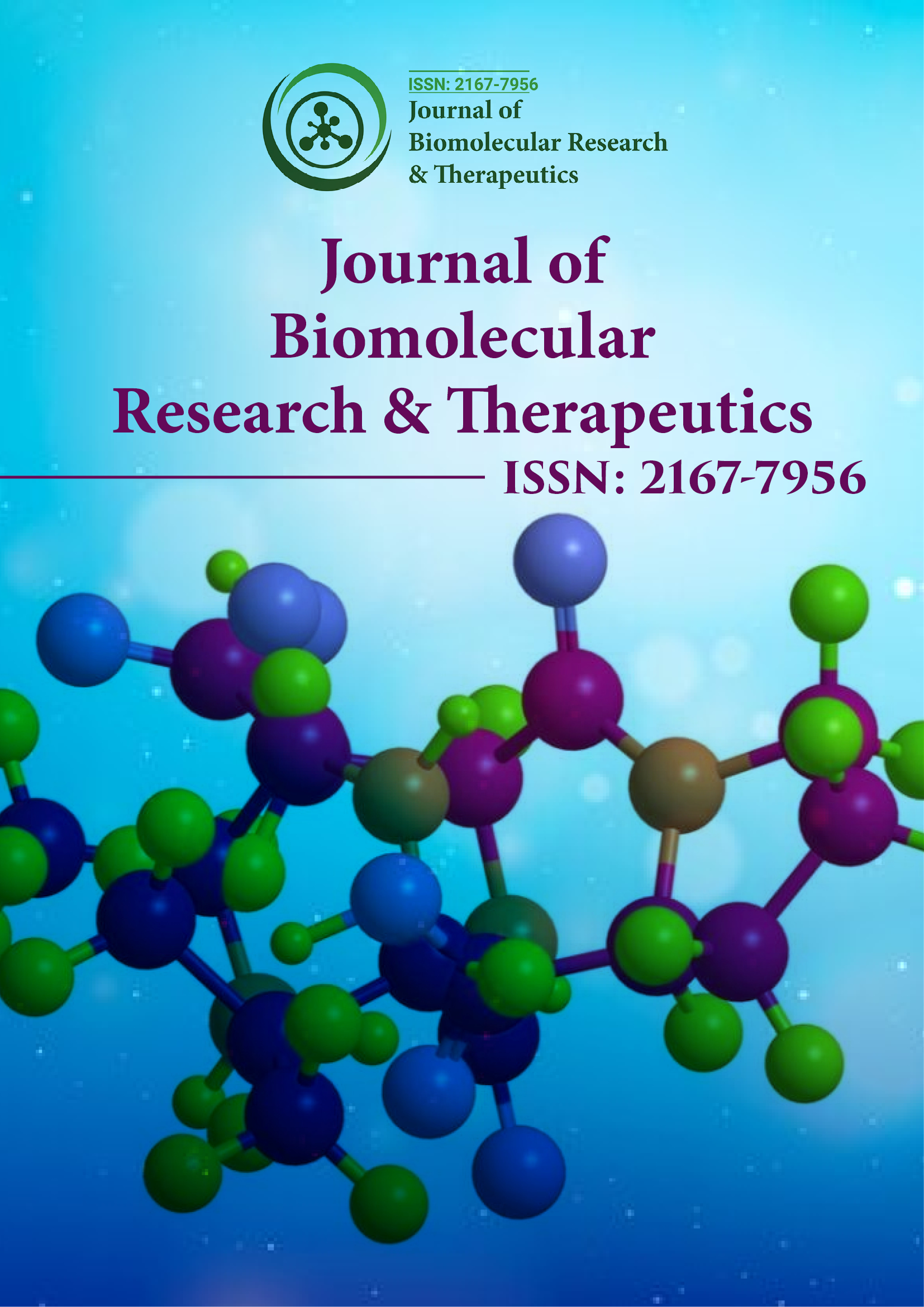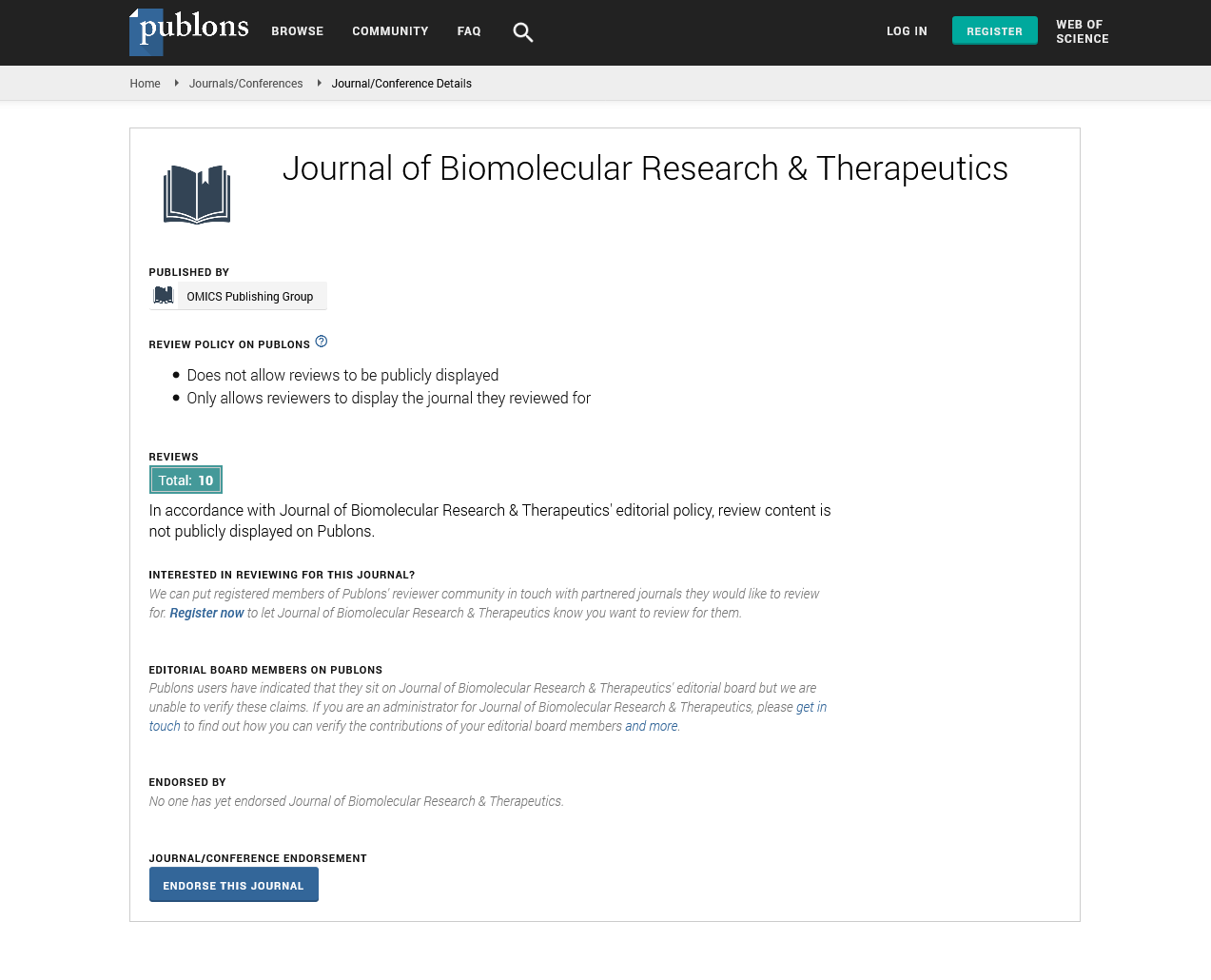Indexed In
- Open J Gate
- Genamics JournalSeek
- ResearchBible
- Electronic Journals Library
- RefSeek
- Hamdard University
- EBSCO A-Z
- OCLC- WorldCat
- SWB online catalog
- Virtual Library of Biology (vifabio)
- Publons
- Euro Pub
- Google Scholar
Useful Links
Share This Page
Journal Flyer

Open Access Journals
- Agri and Aquaculture
- Biochemistry
- Bioinformatics & Systems Biology
- Business & Management
- Chemistry
- Clinical Sciences
- Engineering
- Food & Nutrition
- General Science
- Genetics & Molecular Biology
- Immunology & Microbiology
- Medical Sciences
- Neuroscience & Psychology
- Nursing & Health Care
- Pharmaceutical Sciences
Opinion Article - (2024) Volume 13, Issue 6
Advances in RNA Structural Biology: Decoding Complexity for Therapeutic Breakthroughs
Steve Karen*Received: 29-Nov-2024, Manuscript No. BOM-24-28353; Editor assigned: 02-Dec-2024, Pre QC No. BOM-24-28353 (PQ); Reviewed: 16-Dec-2024, QC No. BOM-24-28353; Revised: 23-Dec-2024, Manuscript No. BOM-24-28353 (R); Published: 30-Dec-2024, DOI: 10.35248/2167-7956.24.13.416
Description
RNA structural biology is an increasingly dynamic field, offering deep insights into the molecular mechanisms of life. The importance of RNA has evolved far beyond its traditional role as a mere intermediary in protein synthesis. As scientists continue to unveil the intricate Three-Dimensional (3D) structures of RNA molecules, it becomes evident that RNA is pivotal in various biological processes, including gene regulation, catalysis and disease pathology. However, despite the tremendous progress made in RNA structural biology, several challenges persist. These challenges are accompanied by exciting opportunities that promise to reshape our understanding of RNA and its roles in cellular functions.
One of the primary challenges in RNA structural biology is the inherent complexity and diversity of RNA molecules. Unlike proteins, which have a more predictable structure-function relationship, RNA molecules exhibit a wide variety of secondary and tertiary structures. RNA is highly flexible and can adopt different conformations depending on environmental conditions, cellular context and interactions with other molecules. This structural plasticity makes it challenging to determine a single "canonical" structure for an RNA molecule. Additionally, RNA’s structural domains are often highly dynamic and exist in equilibrium between multiple conformations, complicating efforts to obtain static structural representations.
Furthermore, RNA molecules can interact with a wide array of proteins, small molecules and other RNAs, often forming intricate complexes. Understanding how RNA folds and interacts with its binding partners requires a comprehensive approach that combines multiple experimental techniques, such as X-ray crystallography, cryo-electron microscopy (cryo-EM), Nuclear Magnetic Resonance (NMR) and single-molecule techniques. While cryo-EM has shown great promise in solving large RNA-protein complexes, it remains limited for smaller, less ordered RNA structures. This highlights the need for continued innovation in methodologies to capture RNA's dynamic nature, especially for low-resolution or transient structures.
Another challenge arises from the difficulty of working with large RNA molecules in vitro. RNA is notoriously unstable and prone to degradation, particularly when isolated from cells. This instability poses a significant obstacle when attempting to purify large RNA molecules or synthesize them in large quantities. While chemical synthesis of RNA has advanced, creating long and complex RNA sequences with high fidelity remains a challenge. Additionally, working with non-canonical RNA structures, such as G-quadruplexes or triplexes, requires specialized techniques and expertise, further complicating the analysis.
Despite these challenges, RNA structural biology has witnessed significant advances in recent years, driven by technological breakthroughs. One of the most notable advances has been the rise of cryo-EM, which has revolutionized the study of large RNA-protein complexes. Cryo-EM allows for high-resolution visualization of RNA molecules in their native, hydrated states without the need for crystallization, overcoming one of the major limitations of traditional X-ray crystallography. This technique has led to the determination of several RNA structures, including the ribosome, spliceosomes and other RNA-related complexes that were previously beyond reach.
Another exciting development has been the growth of singlemolecule techniques, such as single-molecule Fluorescence Resonance Energy Transfer (smFRET), which allow researchers to observe RNA folding in real time. These techniques have provided valuable insights into RNA folding pathways, RNAligand interactions and the effects of mutations on RNA structure. The ability to study RNA dynamics at the singlemolecule level offers unprecedented insight into the behavior of RNA molecules in their native, biologically relevant environments.
The opportunities in RNA structural biology are vast, as the field continues to expand and intersect with other disciplines such as genomics, biophysics and drug design. One of the most exciting areas of opportunity lies in the development of RNAbased therapeutics. RNA-targeting drugs have already made a significant impact in the treatment of diseases like COVID-19 through messenger RNA (mRNA) vaccines. However, RNAbased drugs have the potential to address a much broader range of diseases, including genetic disorders, cancers and neurodegenerative diseases. Understanding the precise 3D structures of disease-associated RNA molecules is critical for developing small molecules or oligonucleotides that can selectively target specific RNA structures, blocking diseasecausing interactions.
Conclusion
RNA structural biology stands at the crossroads of several scientific breakthroughs. While significant challenges remain, particularly in understanding RNA's flexibility, stability and interactions, advances in cryo-EM, single-molecule techniques and computational modeling are overcoming these barriers. The opportunities for RNA research are vast, especially with the promise of RNA-based therapeutics, RNA modification studies and the potential of AI in structural biology. As the field continues to evolve, the knowledge gained from RNA structural studies will undoubtedly open new frontiers in medicine, genetics and molecular biology.
Citation: Karen S (2024). Advances in RNA Structural Biology: Decoding Complexity for Therapeutic Breakthroughs. J Biomol Res Ther. 13:416.
Copyright: © 2024 Karen S. This is an open access article distributed under the terms of the Creative Commons Attribution License, which permits unrestricted use, distribution, and reproduction in any medium, provided the original author and source are credited.

